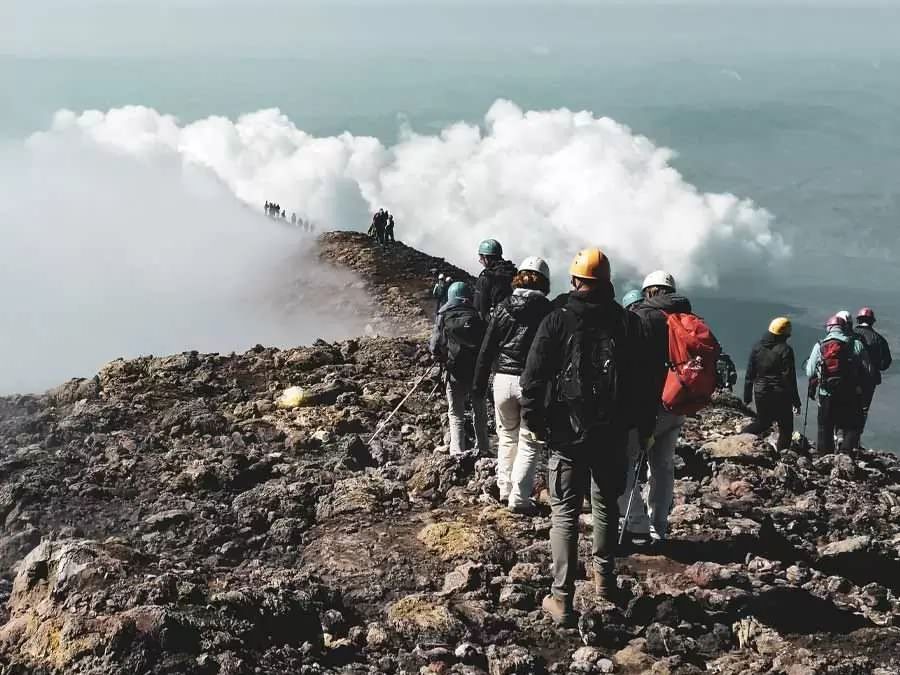The world’s second most active volcano shows us its vehemence: in 2004, a new summit crater is formed which is already history by 2021.
We could say that, just as the beginning of the activity in 1971 was characterised by a collapse on the eastern flank of the Central Crater, so the 2004 collapse on the eastern flank of the Southeast Crater follows the same fracture line and could already be considered as the prelude to the activity that gave rise to the New Southeast Crater.
Since the great eruptions of 2001 and 2002, there has been no noteworthy activity in the Southeast Crater, only a frequent formation of fumaroles, denoting the precariousness of the ground, which slowly led to a succession of collapses of the crater rim and a considerable increase in the diameter of the mouth, especially during the eruption of 2004-2005.
The eruption of 2004-2005
This activity started on 7 September 2004 on the eastern flank of Southeast Crater: various fractures form between 2850 and 2350 metres altitude, the lava flows originate mainly at an altitude of 2650 metres. The flows are only weakly fed and flow sluggishly into the Valle del Bove valley. The lowest point reached is 1450 metres above sea level, still far from inhabited centres. The lava therefore poses no danger.
On 31 October and 16 February 2005, eruptions occurred, forming a depression which then began to subside again in 2006 and 2007, forming a pit crater; eruptive activity ended on 8 March 2005.
The eruptions from 2006
On 13 July 2006, a fissure opened on the south flank of Southeast Crater, producing a cone and lava flows, which in turn were characterised by rather slow emission and remained active for about ten days.
In September and October, there was further activity very similar to that of previous years: effusive vents formed that were essentially free of explosive activity.
It was not until 20 October 2006 that Southeast Crater’s strombolian activity resumed, again violently rupturing the lava field, splitting the recently formed cone and breaking the flows that had just covered the crater rim.
After about a month, the activities are still strong, but they alternate between the summit and the fissures at the base of Southeast Crater. They show strombolian activity and high ash columns until they end on 14 December.
In 2007, there is some rather short-lived strombolian activity of 1 to 10 hours, but this is the last activity of this vent.
Afterwards, the epicentre of activity shifted to the flank again. Exactly where the first collapses had already taken place from 2004, a pit crater formed for the umpteenth time in May 2007. On 4 September, a huge lava fountain formed, which was fed for 12 hours and even triggered a rheomorphic flow. This event was repeated on 23 November and 10 May 2008, and it was these three events that marked out the shape of the cone that would later become the New Southeast Crater.
Immediately afterwards, on 13 May 2008, the lateral eruption started from a fracture in the valley Valle del Leone and spilled into the Bove Valley for 419 days, and so in the meantime it was quiet on our beloved fault line to the east.
In 2009, when it became clear that the cone structure in the area was anything but solid and had deformed considerably, the collapses began again and changed the shape of the crater considerably.
The birth of the New Southeast Crater
A productive series of strombolian activity began in autumn 2010, recording eighteen paroxysms from New Year 2011, seven in 2012 and thirteen in the first half of 2013, and was named the New Southeast Crater (NSEC) on 30 July 2011 during a spectacular lava fountain.
In reality, this cone or new hump of Southeast Crater is nothing more than an opening formed slightly to the east of the previous crater, but the channel is the same, so it is one big crater. The proof is that the activities are very similar and the lava fountains are equally spectacular. During these three years of no less than 56 paroxysmal events, the height of New Southeast Crater exceeded that of Southeast Crater. And if we want to look at the actual duration of the activities that formed, it is really very short, all in all only a few days.
Overall, 2013 was marked by exceptionally violent activity, with lava fountains that were often more than a kilometre high. The events in February, March, April and November also had a significant impact on Etna’s population, with enormous amounts of fallout material. Even blocks with a diameter of 40 cm fell at a distance of 5 km from the crater and fragments with a diameter of 25 cm at a distance of 6 km. This resulted in some minor injuries, damaged cars, centimetre-thick sand mountains on the roads and thus traffic problems.
After more than a decade of inactivity, the Northeast Crater and Bocca Nuova also reawakened in 2013. The flows, which moved southwards from 26 October 2013, distorted the shape of the cone and the entire surrounding area and also destroyed the historic Torre del Filosofo shelter.
After five months of quiescence, another series of lava flows continued the construction of the new crater in late October to early December 2013, raising the New Southeast Crater another 40 metres, completely bridging the gap between the two mouths, filling in the saddle and aesthetically unifying the structural Southeast Crater into a large cone.
